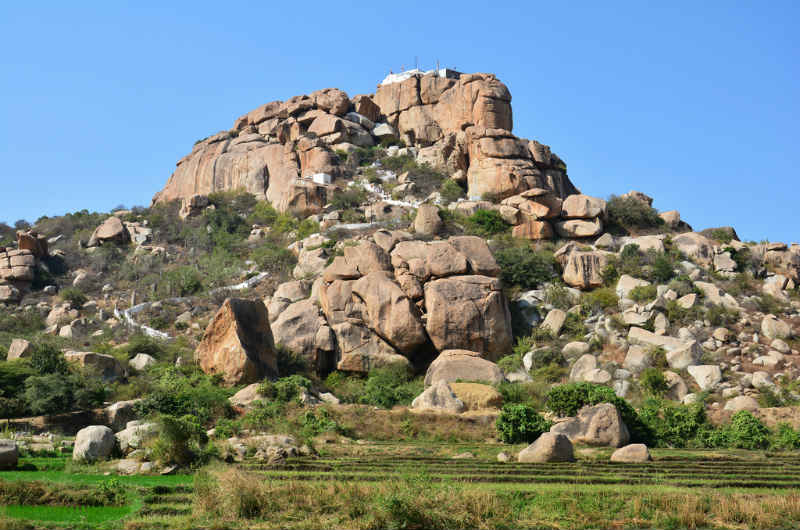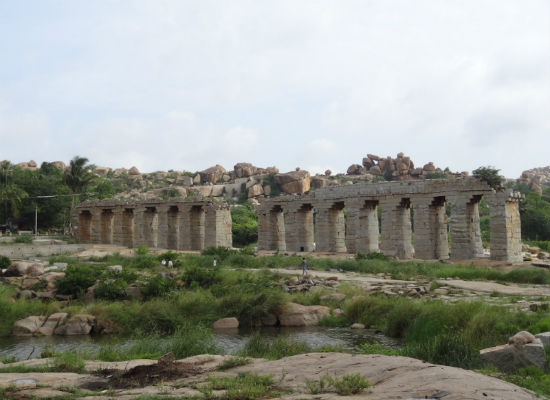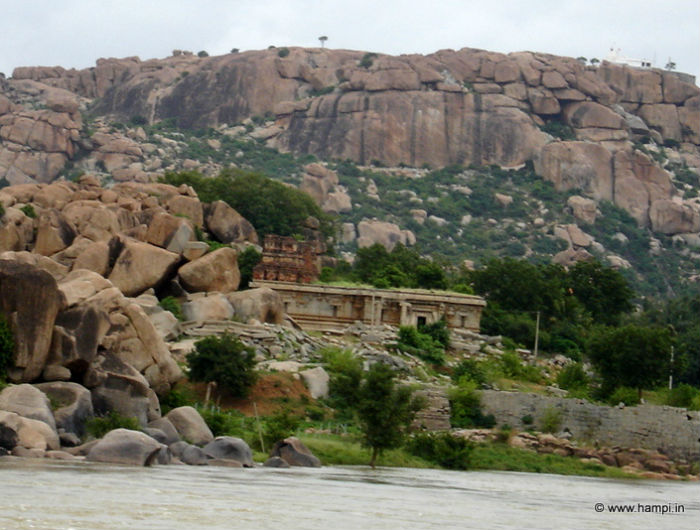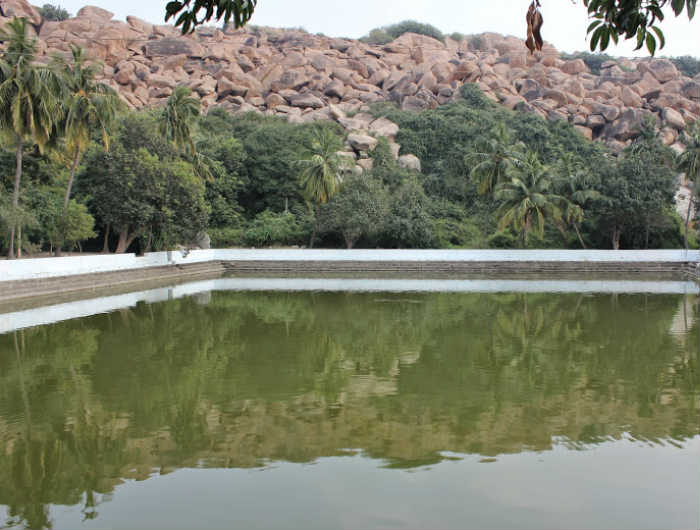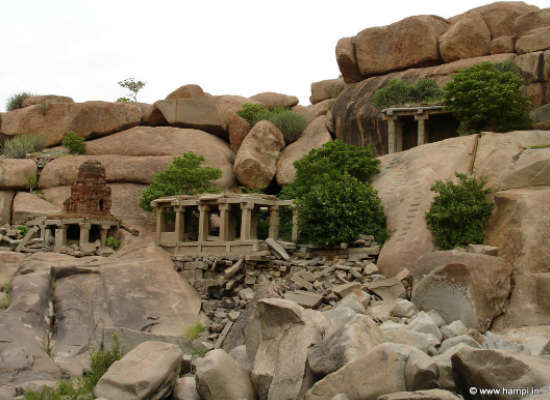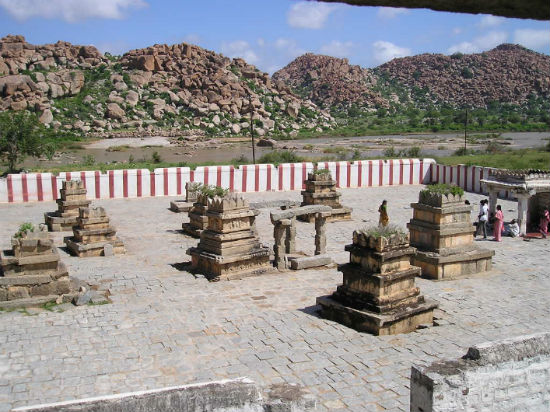Nearest Place
Anjaneya Hill
The hilltop Hanuman temple This hill believed to be the birthplace of Hanuman is located in the center of Anegondi area. You can see this hill from the Hampi side of the river as you trek along the Kampa Bhups’s (the riverside trek) Path. At the top of the hill is the temple dedicated for Hanuman, the monkey god. According to Hindu mythology he was born to Anjana. Thus Hanuman is also known as Anjaneya and his birthplace as Anjaneyadri (Anjaneya’s hill). You can easily spot this hill from a distance as the temple at the hilltop is whitewashed and a white trail of steps zigzagging all the way to the top.Surprisingly the Ramayana (the story of Rama) recited inside the temple is in Hindi, a deviation from the local language Kannada. Those understand Hindi and in interested in Ramayana , listening to this is a feast. The pundit ( an old man with white beard ) is gifted with the expression to tell the story. There won’t be much of people if it is not a special day for the temple. You can just enter the temple and sat next to him, listen and leave whenever you feel. This is done on a continuous basis.
Bukka's Aqueduct
Due to its size, this ancient aqueduct probably makes the high watermark of Hampi’s hydraulics.All what remains of this massive aqueduct is a tall section of a bridge like structure. The whole structure is built with rectangular dressed rock blocks. The unusual height for an aqueduct suggests the ambitious plan to lift huge quantities of water to a suburb located at an elevated plane.If you are staying at one of those huts at Virupapur Gadde, you are probably at a walking distance from these ruins.
Chandramouliswara Temple
Chandramouliswara Temple is located on the north bank of Tungabadhra, in the Rishimukh Island. The ruined ancient bridge once connected this area to the south bank. Because of this location and lack of easy access, visitors do not frequent this place. However Chandramouliswara Temple can be reached by a coracle from near Vittala Temple or through the narrow village paths from the north (i.e. if you have already crossed the river to the north bank). It’s not a bad idea to combine this visit to Chandramouliswara Temple with the other sites scattered around the Anegondi area (Like the Anjeyanadri Hill and Pampa Sarovar)The river confluence at this area has deposited a huge heap of loose sand on this island. This is in contrast with the otherwise rocky and hard terrain of Hampi. Partly owing to the shifting sand, much of temple and its fortified structures are in a stage of crumble. Shrubs have grown all over preventing one from entering the temple pavilions.Constructed during the 13th century, this temple had been an important place of worship during the peak days of Vijayanagara kings. Large arches made of carved stone, stucco figures, intricately carved walls, massive doorways and pillars with motifs adorn the Chandramouliswara Temple.
Pampa Sarovar
Pampa Sarovar is a sacred pond for the Hindus. This is one among a few Sarovars (sacred ponds) has a mentioned in the Hindu epics. The pond and the shrine are located in a valley hidden by boulder hill at the three sides.The pond, rectangular in shape, is usually filled edge-to-edge by the floating lotus leafs. The whitewashed shrine is located right next to the pond. This is a functioning temple and the idols worshiped are of Lord Shiva & his consort Parvathi (Pampa). This shrine is much ancient than many of the temples in Hampi.A vividly painted musical instrument placed in the temple courtyard is interesting. The instrument at a time plays a drum, metal plates and a couple of bells attached to it. The whole thing is driven by a motor attached the mechanisms. These were the temple musical instruments originally played by the temple musicians. Now this machine plays it all together during the prayer time (typically early morning & in the evening).A bit north in the line is the temple kitchen. Just opposite to it under a mango tree is a circular platform built around it. tall Vinayaka (the elephant headed god) statue painted in florescent vermilion.
Rishimukh
Chandramouliswara Temple that’s undergoing a vigorous restoration work. Also this is a vantage point to see the ruins of the ancient bridge built across the river. Close to this temple is an Ashram (hermitage) from where you can hear practically nonstop chanting of the sacred texts.If the river is not flooded, you can crossover to this area by a coracle from near the Kodandarama Temple (pay Rs 5 to 10 per head). Otherwise the same kind of ferry option is available at the river crossing point some distance east of Vittala Temple. In the later case you’ll need to trace a few kilometers before reaching this locality. If you are planning for a long exploration, taking along your bicycle or moped is a good idea as public transport is a bit scarce at this side of the river.
Navabrindavanam
Brindhavanam generally means saints & great rishis are living after their life. Navabrindavanam is a nice place, which is located at Anegundi, near Hampi, Karnataka. India. There are nine saints in this Brindavanam. IN Navabrindavanam, nine of the great Madhwa(belonging to the kith and kin of Madhwacharya,the founder of the Dwaita or dualism tenets) are eternally resting , still alive.the “brindavanas” are the tombs of their resting
Anegondi which literally means elephant pit in Kannada is a small village in Koppal district of Karnataka state, located on the north banks of the Tungabhadra River on the opposite bank of the Vittala Temple. Anegondi was famous for becoming the original capital city of the Vijayanagara Empire when Mohammad Tughlaq, Sultan of Delhi, defeated the King of Anegondi (Jambukeshwara Raya) and appointed Malik Nayab as his representative to rule over the city.

